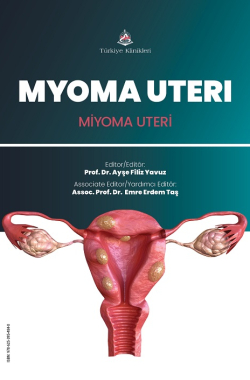Myomectomy with Robotic Surgery
Ali Akdemir1
Sabahattin Anıl Arı2
1Ege University, Faculty of Medicine, Department of Gynecology and Obstetric, İzmir, Türkiye
2İzmir Bakırçay University, Faculty of Medicine, Department of Gynecology and Obstetric, İzmir, Türkiye
Akdemir A, Arı SA. Myomectomy with Robotic Surgery. Yavuz AF, ed. Myoma Uteri. 1st ed. Ankara: Türkiye Klinikleri; 2025. p.103-110.
ABSTRACT
The development of surgical robotics was driven by the desire to overcome the limitations of tradi- tional laparoscopy, such as two-dimensional imaging, rigid instruments, and ergonomic challenges. Robotic-assisted laparoscopic surgery improves patient outcomes by converting procedures that would normally require a laparotomy into minimally invasive interventions. The choice between a minimally invasive myomectomy and a laparotomy largely depends on the surgeon’s expertise and the location, size, and number of leiomyomas. Robotic instruments, offering seven degrees of freedom, enable ‘En- doWrist’ movements that closely replicate the dexterity of the human hand, greatly facilitating tasks like suturing, particularly for less experienced surgeons. Despite its benefits, robotic technology has some drawbacks, including the need for specialized training, higher costs, longer operating times, bulky equipment, elevated instrument expenses, limited tool flexibility, lack of tactile feedback, and potential for mechanical failures. Bleeding, although common in all myomectomy procedures, tends to be less severe in robotic myomectomy. Maintaining a hemoglobin level above 12 g/dL is critical to minimize complications, as the risk increases with lower levels. The use of the third robotic arm to manipulate the myoma provides a significant advantage over conventional laparoscopy in myomec- tomy procedures. When power morcellation is necessary, it should be performed within a completely enclosed endo bag to prevent tissue dissemination. Gynecologic surgeons should strive to limit the use of power morcellation whenever possible, as newer techniques have been developed to minimize the risk of unintended tissue spread.
Keywords: Fertility preservation; Minimally invasive surgery; Morcellation; Robotic myomectomy; Tissue removal
Kaynak Göster
Referanslar
- Donnez J, Dolmans MM. Uterine fibroid management: from the present to the future. Hum Reprod Update 2016;22:665-86. [Crossref] [PubMed] [PMC]
- Oppenheimer P, Weghorst S, Macfarlane M, Sinanan M. Immersive Surgical Robotic Interfaces. Stud Health Technol Inform 1999;62:242-8. [Crossref]
- Wee IJY, Kuo LJ, Ngu JCY. A systematic review of the true benefit of robotic surgery: Ergonomics. Int J Med Robot 2020;16. [Crossref] [PubMed]
- Flyckt R, Soto E, Nutter B, Falcone T. Comparison of LongTerm Fertility and Bleeding Outcomes after Robotic-Assisted, Laparoscopic, and Abdominal Myomectomy. Obstet Gynecol Int 2016;2016. [Crossref] [PubMed] [PMC]
- Kim S, Luu TH, Llarena N, Falcone T. Role of robotic surgery in treating fibroids and benign uterine mass. Best Pract Res Clin Obstet Gynaecol 2017;45:48-59. [Crossref] [PubMed]
- Chen W, Ma J, Yang Z, Han X, Hu C, Wang H, et al. Robotic-assisted laparoscopic versus abdominal and laparoscopic myomectomy: A systematic review and meta-analysis. Int J Gynaecol Obstet 2024;166:994-1005. [Crossref] [PubMed]
- Dueholm M, Lundorf E, Hansen ES, Ledertoug S, Olesen F. Accuracy of magnetic resonance imaging and transvaginal ultrasonography in the diagnosis, mapping, and measurement of uterine myomas. Am J Obstet Gynecol 2002;186:409-15. [Crossref] [PubMed]
- Soper DE, Chelmow D. ACOG Practice Bulletin No. 195: Prevention of Infection After Gynecologic Procedures. Obstetrics and Gynecology 2018;131:E172-89. [Crossref] [PubMed]
- DJ S, A G. Robot-Assisted Laparoscopic Myomectomy: A Comparison of Techniques. J Minim Invasive Gynecol 2015;22:S18. [Crossref] [PubMed]
- Tsuji S, Takahashi K, Imaoka I, Sugimura K, Miyazaki K, Noda Y. MRI evaluation of the uterine structure after myomectomy. Gynecol Obstet Invest 2006;61:106-10. [Crossref] [PubMed]
- Wallach EE, Vlahos NF. Uterine myomas: an overview of development, clinical features, and management. Obstetrics and Gynecology 2004;104:393-406. [Crossref] [PubMed]
- Goldberg HR, McCaffrey C, Amjad H, Kives S. Fertility and Pregnancy Outcomes After Robotic-assisted Laparoscopic Myomectomy in a Canadian Cohort. J Minim Invasive Gynecol 2022;29:72-6. [Crossref] [PubMed]

